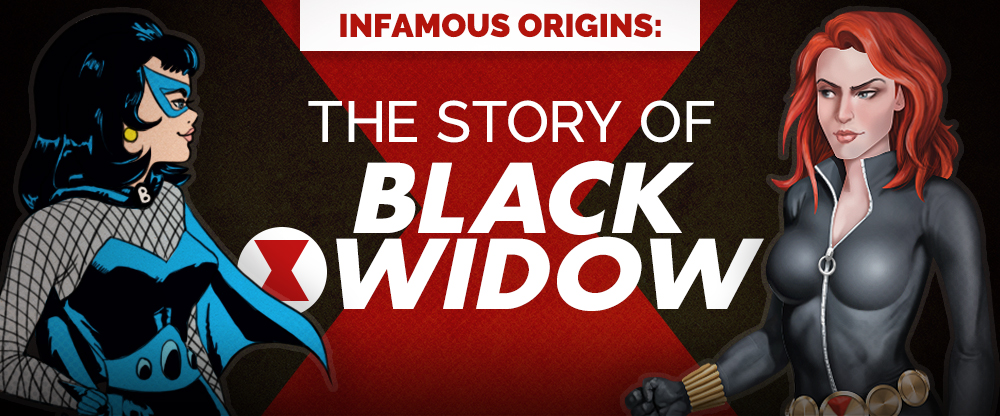Black Widow may have had a sordid past, but after her inclusion in the Avengers movies and the introduction of her own TV series, Natasha Romanoff has become a prominent character in pop culture media. She may have more nicknames and aliases than you have fingers on both hands, but that's simply part of her job as a super-spy. From her role as a minor Iron-Man villain to one of the most recognizable Avengers characters, Black Widow managed to beat the odds without incredible superpowers! (Granted, she has slowed aging and superhuman durability, but Romanoff doesn't have any of the flashy superpowers like flying or super strength.) There's certainly much more to this leading lady than meets the eye, so let's delve a little further into the history of Black Widow.
Being a super-spy isn't always everything it's cracked up to be, as Natasha knows. Her character went through some major changes over the years—including taking a variation of super-soldier serum, stealing another Marvel character's costume and headlining on another comic to save Daredevil's series. We'll mention that there was also an earlier "Black Widow" character dating back to the 1940s that worked for Satan, but she's not related to this Natasha. Black Widow's main claim to fame is the fact that she's Marvel's first female superhero to have her own comic book series, granted with some complications there, too. We'll be breaking everything down for you, so keep reading to learn more about Marvel's Black Widow!
The Creators of Black Widow
Stan Lee
The character concept for Black Widow was created by Stan Lee. Originally included in the comics as a villain and Russian spy intent on infiltrating Stark Industries, Natasha eventually defected from the Soviet Union and became a superhero. Throughout his lifetime, Stan Lee created more than 100 comic book characters, some of which you can see in the MCU. (Spider-Man, Nick Fury and Ant-Man, to name a few!) Born in New York on December 18, 1922, his name was originally Stanley Martin Lieber. He graduated from high school at the age of 16 and immediately jumped into the comics industry as an editorial assistant for Timely Comics. (And he never left comics!)
Stanley eventually worked his way to the position of editor, and it was around this time that he had already begun writing a few comic book scripts on his own. He wrote his comics under the name "Stan Lee", which would eventually become his legal name. Timely Comics later became Atlas Comics, although times were tough and they were struggling financially. Stan Lee created a few comic book series, although these early titles didn't perform very well. It wasn't until 1961 when Atlas comics (now Marvel Comics) had their first real hit—the Fantastic Four! Spider-Man, The Hulk and the X-Men soon followed in the early 60s, and eventually, Black Widow was introduced in Tales of Suspense #52 in 1964.
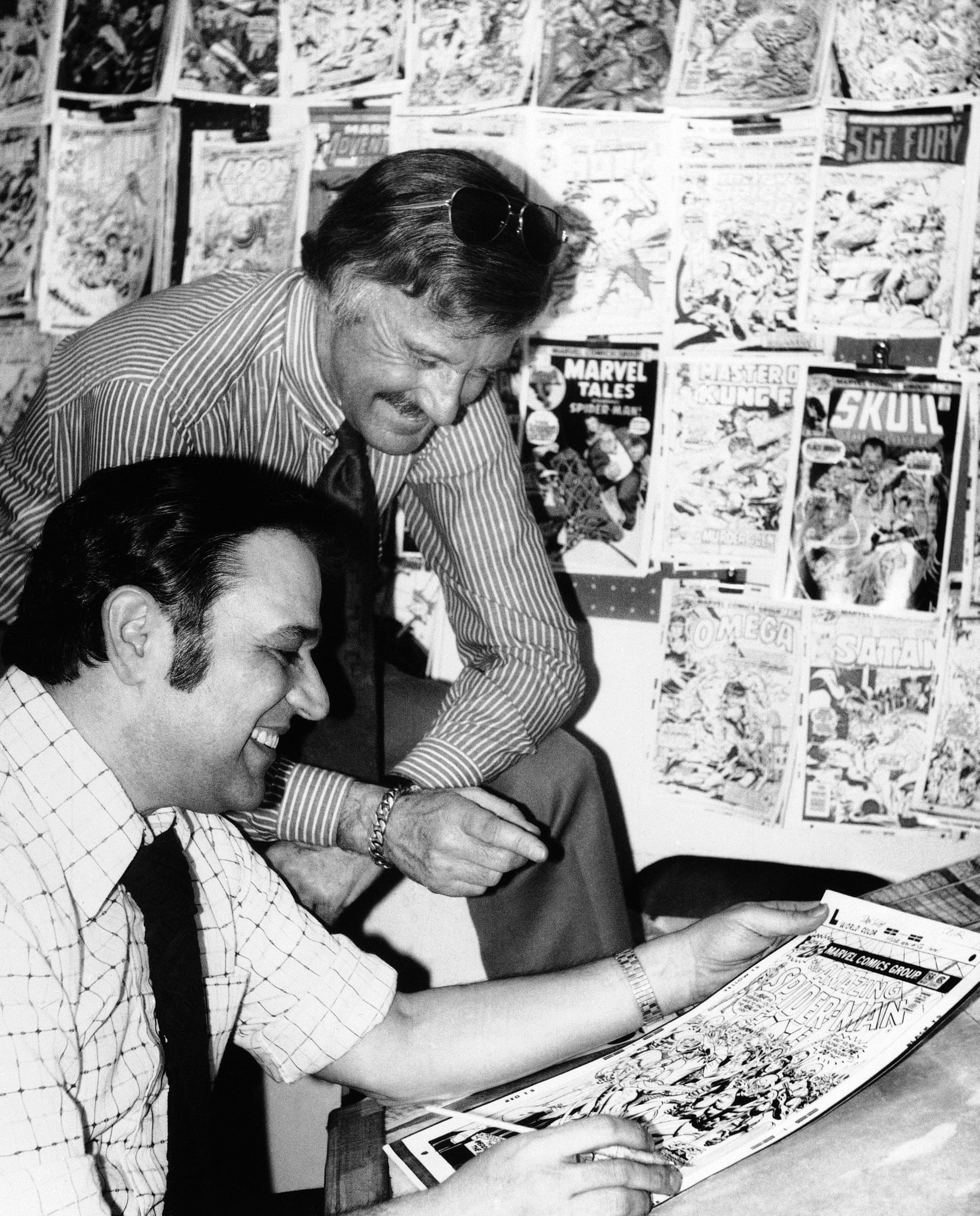
Stan Lee at Marvel Headquarters with Artist John Romita, 1976. [Source: AP/The Guardian]
Don Rico
Don Rico was a man of many talents. He wrote paperbacks, dabbled in comic book writing and screenplays, did some wood engraving and drew comic book art. Rico started during the Golden Age of Comics in 1939, at Fox's Publications where he was a comic book artist. He then moved on to Timely Comics, where he continued to work as an artist. Like anyone else looking to expand his or her career, Rico dabbled in work at several other publications, including Fawcett Publications, Terrific Comics, Novelty Press and Target Comics. When Timely Comics started transitioning to Action Comics in the 1950s, Don's role changed from artist to writer.
At the end of the 50s, Don Rico moved to Los Angeles and he began writing for television and movies. He continued to try other forms of writing, and his career in the 1960s transitioned to paperback books for publishers like Paperback Library and Lancer Books. For the most part, Rico was done writing comic books, but he did work on three in the 1960s—two of which were the Tales of Suspense #52 and #53 with Iron Man and Black Widow. Interestingly, Don didn't want his paperback publishers to find out that he took a comic book writing side gig for less pay, so he wrote these three comics under the pen name N. Korok.
Don Heck
Don Heck started his career as a comic book artist in 1949 at Harvey Comics. He spent short stints at other comic book companies before he settled in at Atlas Comics/Marvel Comics. Don started doing art for war titles and jungle-themed comics before he began working with superhero comics. The first superhero comic book that Don illustrated was actually the 1964 Tales of Suspense Iron Man and Black Widow story! Heck continued to draw comics, some of his most famous including Captain Marvel, X-Men, Daredevil and Ghost Rider. There was a time that he did some comic work for DC as well, including work on comics like The Flash, Wonder Woman and Batgirl, but Don returned to Marvel in his later years.
The Biography of Black Widow
Silver Age
Seeing as Black Widow was first introduced in 1964, she began in the era of comics known as the "Silver Age" from the mid-1950s to around 1970. She debuted in Tales of Suspense #52 (April 1964). Very little is known about her character, other than the fact that she was a Russian spy who worked for Boris Turgenov. In her early missions to disrupt life at Stark Industries, Black Widow bumped into a young Hawkeye and persuaded him to aid her in her criminal endeavors. However, their criminal career didn't last very long because she began to fall in love with Hawkeye, who was ultimately not a criminal at heart.
After her first failed mission, Black Widow went back to Russia where she was given some new gear that made her even more spider-like—including a suit that allowed her to cling to walls and a device that could shoot lines to swing from. (Now if that doesn't sound a lot like another superhero that we all know and love....) Hawkeye and Black Widow tried a second job on Stark, which again failed. By this time, the Russians were fed up with Natasha botching her job, so they shot her. Black Widow didn't die, but the near-miss concerned Hawkeye enough to take her to a hospital, quit his villainous streak and join the Avengers.
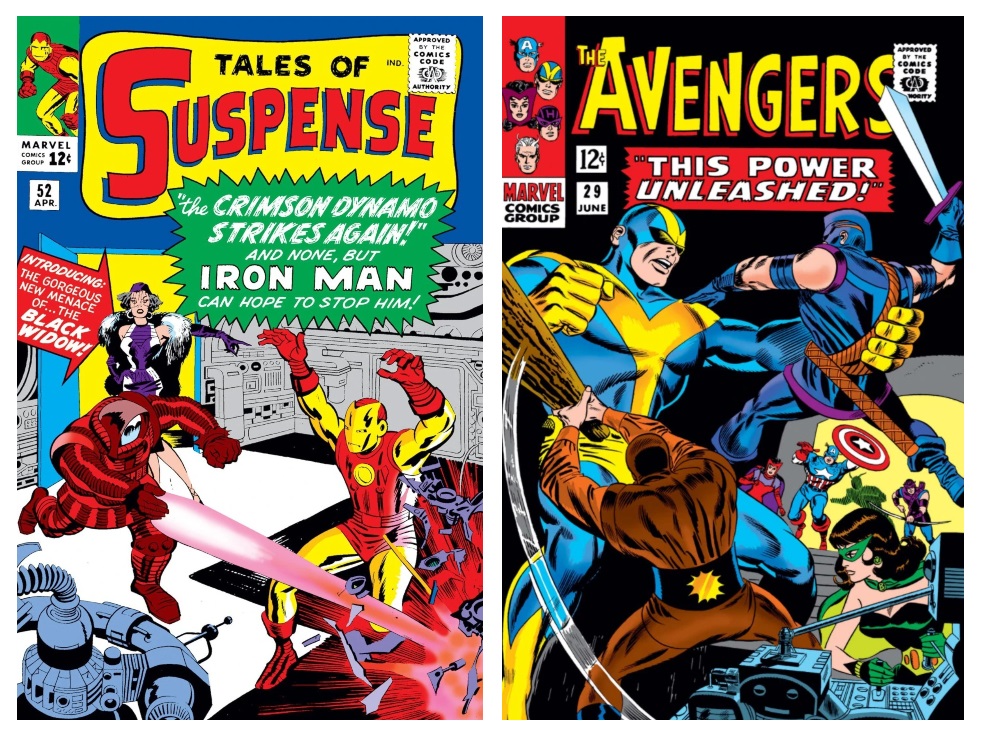
| Tales of Suspense #52 (April 1964), published by Marvel Comics [Source: Fandom.com] | The Avengers #29 (June 1966), published by Marvel Comics [Source: Fandom.com] |
The Russians found out that she didn't die, so they captured and brainwashed Black Widow, then sent her back to America to defeat the Avengers (and her almost-boyfriend Hawkeye). She traveled along with Swordsman and Power Man as backup. Thankfully that ship sailed, she lost and Natasha recovered from the brainwashing. Black Widow clearly felt bad for attacking the Avengers against her will, so she aided them in several missions in hopes of joining their team.
While that nearly came to pass, Nick Fury approached Black Widow with a solo mission to spy on her former Russian boss, which forced her to decline her invitation to the Avengers and eventually branded her as a traitor. Unfortunately, upon meeting up with her former Russian employers in China, they immediately knew that something was up when she returned of her own free will. (It's not like they previously tried to kill her then had her captured and brainwashed!) They promptly locked her up, initiating a rescue by the Avengers.
These events were nearly enough to make Natasha stop pursuing a line in hero work, but she ultimately fell back into it. Her next S.H.I.E.L.D. mission also led to her capture by the bad guys once again, but Hawkeye (now Goliath after Pym's growth formula), came to her rescue again. In retrospect, Black Widow spent most of the Silver Age life as a femme fatale, but she soldiered on in pursuit of something better.
Bronze Age
In the Bronze Age of comics, Black Widow was still trying to find her niche. She went solo for a bit, had several high-profile team-ups and did some more S.H.I.E.L.D. work that got her captured yet again. (It's a wonder she kept going back for more!) At least she started her Bronze Age solo career off with a brand new, sleek black costume ("borrowed" from Miss Fury) and her "widow bites" bracelets.
After acquiring her new gear, Black Widow sought to prove herself by beating Spider-Man, which she failed to do even though he was ill and not in peak physical condition. Natasha took her failure in stride and learned from it instead, so she began fighting with the villain of the week.
In the early 1970s, Daredevil comics were on the decline, so Marvel introduced a partnership between Black Widow and Daredevil to breathe new life into the comic series. Their dynamic worked so well that Black Widow and Daredevil's team-up comic series lasted for several issues. (And it even caught the attention of David Bowie and his wife, who nearly made a Black Widow and Daredevil TV series!) After her partnership with Daredevil, Black Widow took yet another S.H.I.E.L.D. gig that ended with her getting captured and brainwashed by Hydra. Fortunately, Spider-Man recognized her (as the brainwashing led to her taking on her Nancy Rushman alter-ego), and they teamed up to take down Hydra.
Afterward, Black Widow co-founded the short-lived Champions of Los Angeles, a team of superheroes that quickly went bankrupt. These failures led Natasha to the conclusion that she needed to absorb herself into some more solo work. She managed to succeed on several of her solo missions, including foiling a plot to assassinate Nick Fury.
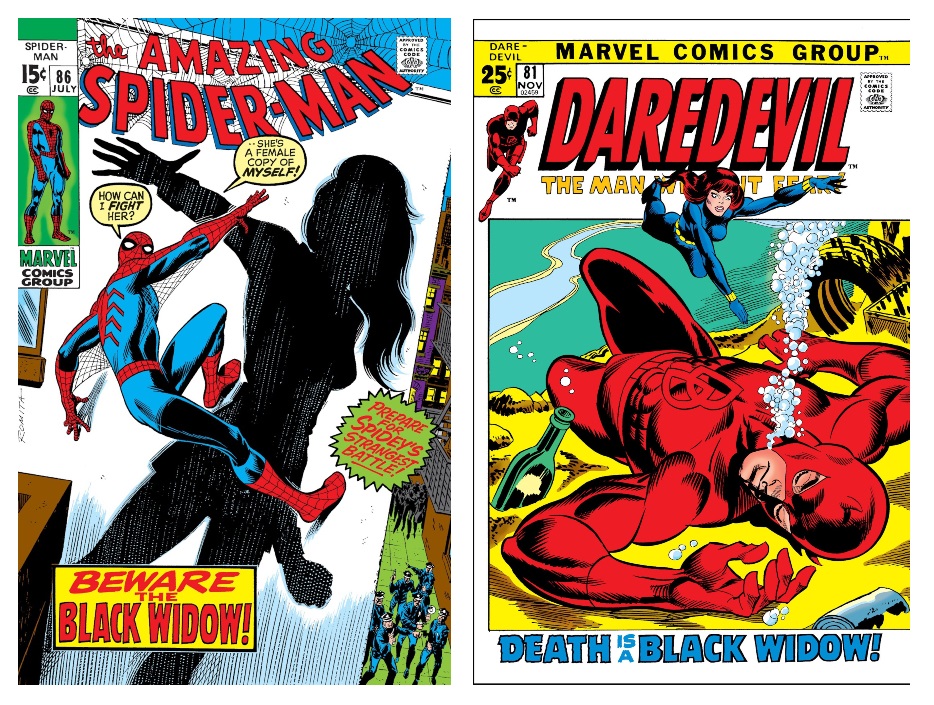
| Amazing Spider-Man #86 (July 1970) [Source: Fandom.com] | Daredevil #81 (November 1971) [Source: Fandom.com] |
Modern Age
Black Widow began to blossom in her solo career. She foiled another Russian plot, this time without getting captured or brainwashed and having to be saved. When she teamed up with Iron-Man, they prevented the beginning of World War III. Her efforts eventually led her back to the Avengers, where she became a co-leader. (Granted, the Avengers team nearly got wiped in the Onslaught saga and she blamed herself for it, but it's hard to say if that encounter could have gone any better.)
There were additional team-ups with Daredevil, but in the 90s, Black Widow realized that she had to back off because Daredevil had a girlfriend who was getting jealous. (Let's just say that Matt and Natasha's relationship became complicated even after that—Darevevil's girlfriend died and Matt attempted to throw a baby off a rooftop. It was messy.) Ultimately, they didn't end up together, but Natasha had some bigger problems of her own to deal with.
Another female Russian agent decided to take up the mantle of "Black Widow", which brought the two of them to a head. The encounter went very badly for the Russian agent, Yelena Belova, as Natasha captured her and surgically swapped their faces so she could get a handle on what General Stalyenko was doing. He managed to see through Black Widow's rather extreme ploy, although it wasn't a total loss because she prevented him from selling some of his nuclear weapons.
After all the craziness, it's a wonder that Black Widow was able to continue as she did. However, there was one thing that did make her retire—for a time. Over the decades of Black Widow comics, she had several complicated encounters with her husband, Alexi. He was supposedly killed early-on, but then she found him alive sometime later. Romanoff found Alexi dead and alive a few more times, and she was even tricked by a robot version of him at one point. Fast-forward to 1994, and Natasha agreed to work with S.H.I.E.L.D. once more. The Russians wanted to hand Madame Hydra over to S.H.I.E.L.D. in exchange for Black Widow, but they weren't about to do it without knowing who was behind the Russian plot. As it turned out, the man behind the Russian scheme was Alexi. Black Widow, Daredevil, the Avengers and S.H.I.E.L.D. managed to arrest Alexi and take him into custody, but the stress of dealing with her living-again-dead-again husband led Natasha to retire from hero work.
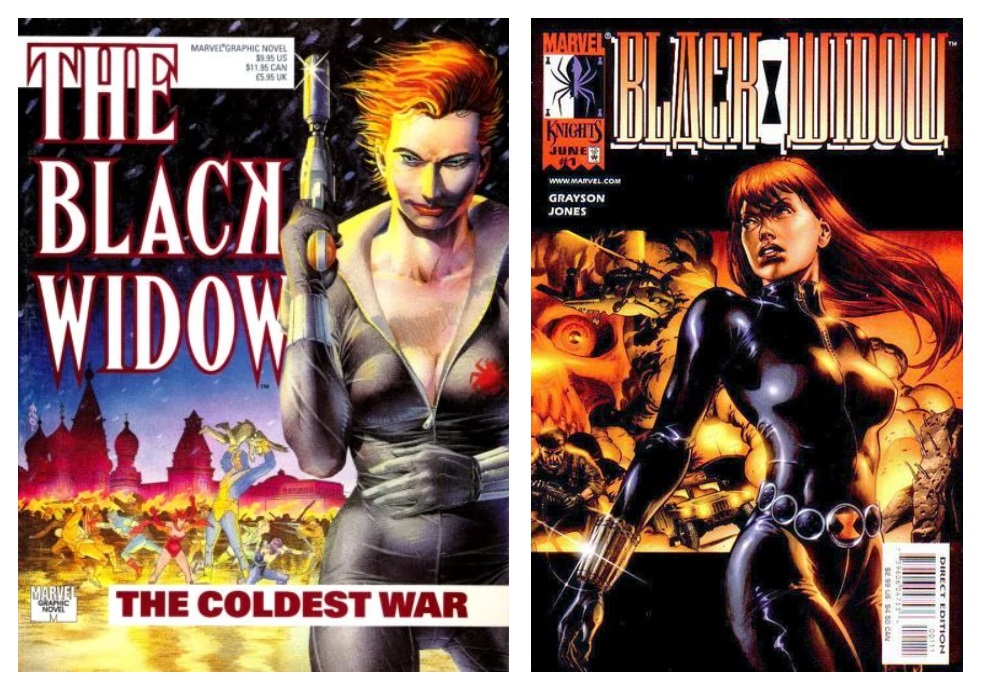
| Marvel Graphic Novel #61 (April 1990) [Source: Fandom.com] | Black Widow #1 (June 1999) [Source: Fandom.com] |
Widow's Hunt and Secret War
It's hard to stay retired after living as a super-spy and superhero for as many years as Black Widow had—her past was going to catch up with her, it was only a matter of when and where. (Very little of Natasha's past was explained in the comics until we reached the Modern Age, so we finally get some more solid backstories here!) Agents from the Red Room began tracking down and killing previous Black Widow agents, girls like Romanoff that were trained to become assassins.
In an effort to stay ahead of the game, Natasha enlisted the aid of S.H.I.E.L.D.'s Phil Dexter to help her track down the Red Room agents. They found Sally Anne Carter and Lyudmila Antonovna Kudrin, two women associated with the training program. Natasha managed to figure out that there were 27 girls trained in the Red Room to be the perfect killing machines. The girls were chemically enhanced, brainwashed and had pheromonal keys and locks implanted in their bodies as a means of controlling them.
Natasha kept following the Red Room trail until it led her to Vassily Ilyich Ulyanov and Ian McMasters, and she killed them both. (Unfortunately, Ian was the CEO of Gynacon, a large organization in the United States, and she became the most wanted criminal in America.) In an odd twist, Natasha sought the help of Yelena Belova in Cuba—the lady whose face she surgically stole. It's a wonder that she allowed Natasha to stay with her, although in exchange, Romanoff was asked to move stolen medical supplies from Miami. (Ironically, medical supplies from Gynacon.) Black Widow ended up getting captured and brainwashed (yet again) for her efforts, and she was rescued by Yelena and Daredevil.
Black Widow's next job tasked her with hunting down the Tinkerer, as it was believed that he knew who was financially backing the supervillains of America. Things became a bit more complicated when Widow and Fury found out that the person was the Prime Minister of Latveria, Lucia von Bardas. (FYI, Latveria is not a real country.) Nick Fury wanted to overthrow the Prime Minister, but the President of the United States didn't agree with it. Rather than taking the President's word, Fury assembled a team of heroes meant to covertly overthrow Bardas anyways. The heroes ended up agreeing that they shouldn't be messing with government politics, so Nick Fury had most of their memories erased.
Civil War and the Thunderbolts
Black Widow was involved in the superhero Civil War in the comics, with a similar role in the Avengers: Civil War movie. She sided with Iron Man, who supported the Superhuman Registration Act. (Which is a little ironic if you really think about it, given the fact that Tony and Natasha aren't terribly "super".) After registering as a superhuman, Black Widow joined Tony Stark and became part of their new Avengers group. At one point Black Widow ended up as the default leader of the new Avengers crew, with Iron Man and Maria Hill unable to continue in the role.
Taking on more work for Nick Fury, Natasha once again assumed the role of Yelena and joined the Thunderbolts, a team of mostly reformed former villains. (There's a decent amount of murky gray space here.) At the time the team is working for Norman Osborn, and they do a few minor missions before being tasked by Osborn to kill one of their former members, Songbird. Nick Fury tells Natasha that she needs to first rescue Songbird, as he wants any information she might have on Osborn and his current operation. While Black Widow managed to get Songbird to Fury, the Thunderbolts weren't that far behind and they captured all three of them. Osborn then reveals that he has been sending messages as Fury all along—gotta love those bad guy monologuing moments—and orders the Thunderbolts to kill Songbird and Black Widow. Thankfully, a few of the Thunderbolts including Ant-Man keep the rest of them from killing the two women.
Deadly Origin
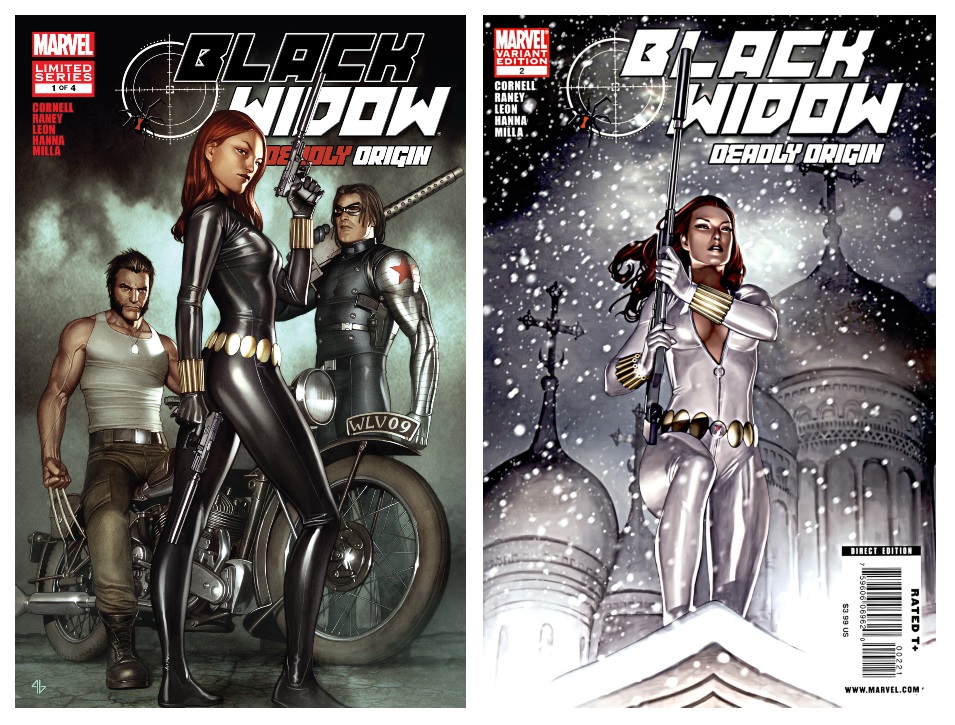
| Black Widow: Deadly Origin #1 (November 2009) [Source: Fandom.com] | Black Widow: Deadly Origin #2 (December 2009, Variant Cover) [Source: Fandom.com] |
While Black Widow continued to be involved in various comic book plots, the MCU and her comic stories rarely intersected. Her lack of a proper backstory was a hurdle for introducing her in the Marvel Cinematic Universe, so the Black Widow: Deadly Origin mini-series of comics was introduced ahead of Iron Man 2 to flesh out her history with the Red Room. Natasha's background with the Russians and the Red Room was rewritten a little bit, and it had an impact on the making of Avengers: Age of Ultron. As another interesting tidbit, Black Widow had a white outfit in Deadly Origin that's included in the Black Widow TV series.
We hope you enjoyed this deep-dive into the history of Black Widow! Was there anything that surprised you? What are some of your favorite aspects of her character? Do you feel like the MCU made her better, or do you prefer Black Widow comics? Feel free to share your thoughts with us in the comments. If someone you know (or you) is a big fan of Black Widow, you might want to take a peek at our selection of Black Widow gifts or our ultimate guide to Marvel gifts!
Sources: Marvel Directory, Screenrant, Looper, Fandom.com, Encyclopedia Britannica, Lambiek.com, CBR and Wikipedia.
 Blog Home
Blog Home Artwork
Artwork Gift Guides
Gift Guides Infographics
Infographics Printable Crafts
Printable Crafts Resources
Resources Tutorials
Tutorials Contests
Contests Costumes
Costumes Quizzes
Quizzes Recipes
Recipes